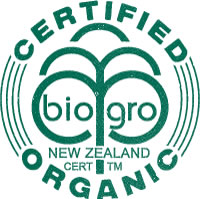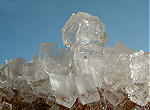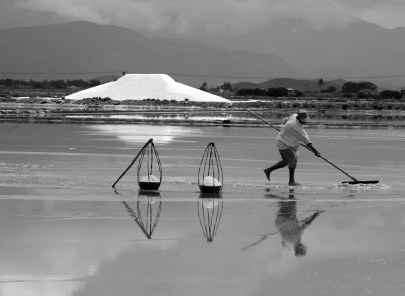
Artisan ~ Salts that are produced by means other than evaporation, artisans salts typically include smoked salts. Geographical areas that are not favorable to natural evaporation turn to the use of solar houses and other techniques for the drying of salt.
Brine ~ A strong saline solution. Brine can be used as cooling method, such as in the production of ice cream at home.
ABio-Gro ~  New Zealand based organic certifying organization. Salt producers in New Zealand that wish to put the label of "certified organic" on their products would go through this Bio-Gro certification process.
New Zealand based organic certifying organization. Salt producers in New Zealand that wish to put the label of "certified organic" on their products would go through this Bio-Gro certification process.
Chloride ~ One of two elements that makes salt. An essential part of daily nutrition.
Crystals ~  A crystal is a solid that is formed by a three dimensional repeating pattern of atoms, ions or molecules, with a fixed distance between the parts. Salt has a crystalline structure.
A crystal is a solid that is formed by a three dimensional repeating pattern of atoms, ions or molecules, with a fixed distance between the parts. Salt has a crystalline structure.
Epsom Salt(s) ~ This is hydrated magnesium sulfate. The name is derived from the town of Epsom, England where these "salts" were originally made by boiling down mineral waters naturally occurring in the town. The uses of epsom salts are numerous. They are used in making textiles and fertilizers. They can be added to bath water or as a foot soak to soothe skin. Their medical uses include the prevention of seizures, as a laxative, to treat heartburn, to treat constipation, as a bronchodilator and to treat mild magnesium deficiencies.
Grinder ~ Puegeot invented the pepper grinder in 1842 and we could assume that salt was tried in this mechanism. The food burr mill was also a type of grinder used for salt, spice and coffee grinding.
Low salt ~ 140mg or less of salt per serving.
NaCl ~ Na = Sodium, Cl = Chloride ~ Sodium Chloride
Nature & Progress Certification ~ A French certifying organization
Open Salt ~ This is a small container for holding salt, usually placed on the dining table. Salt is served from it with a salt spoon. Synonymous with the term "salt dip".
Paludier ~ A person that prepares salt by raking.
Pearls ~ Balls of salt that form naturally from ideal environmental conditions of wind and high rates of evaporation. Typically sorted by grain size into fine, petite, pearl. Lake Assal in Djibouti, Africa is one place where this salt originates. Lake Assal is considered to be the saltiest body of water on the planet at 380 grams of salt per liter.
Saline ~ Consisting of salt or containing salt.
Salinity ~ The quality or degree of being saline. The salinity of the worlds oceans is approxiametly 3% - 3.5% and does generally vary by ocean.
Salt Box ~ As it relates to a home, this is a box used for keeping salt. These boxes often have sloped lids, similar to a roof on a house.
Salt Cellar ~ This is a dish used for holding salt. These are usually fairly small and are often designed to be placed on the dining table. They can be made of almonst any material, most commonly glass, silver, or pottery. Some salt cellars have lids. For other types of containers for salt, see salt pig, salt box, salt dip, salt dish and open salts.
Salt Dip ~ A small open dish for holding salt. These are most often found on dining tables and can be quite ornate. A salt spoon is used to serve the salt from the container. A salt dip is the same thing as an "open salt".
Salt Dish ~ As it relates to home use, a salt dish is a general term for a small open container that holds salt. Open salts, salt dips, salt cellars and salt pigs are types of salt dishes.
Salt Free ~ 5mg or less of salt per serving.
Salt Pig ~ This is a type of open container for salt. Most often these are made out of pottery, and the opening is quite large - large enough to allow the cook to grab a pinch of salt out of the opening.
Salt Spoon ~ A very small spoon that is used for dispensing salt from an open container.
Saltern ~ A saltern is an older English term for saltworks. It refers to a building or a place where salt is made by boiling or evaporation.
Saunier ~ Salt worker or seller.
Sodium ~ A soft, waxy, silver - white metallic element of the alkali group, and occurring abundantly ~ always combined ~ Found in the animal body, especially the fluids and most plants. Periodic Table symbol for sodium is Na. Atomic weight of 22.98976928
Very low salt ~ 35mg or less of salt per serving
![]() Home
Home
![]() About
About
![]() Sitemap
Sitemap
![]() Credits
Credits
![]() Privacy
Privacy
![]() Advertise
Advertise
![]() Contact
Contact
![]()